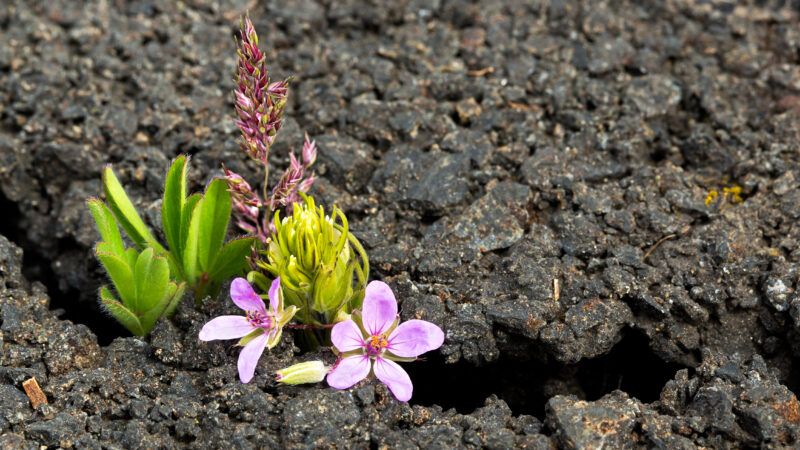The Great COVID Rupture
Three years after "15 days to slow the spread," things almost look like they're back to normal. But they're not.

On the three-year anniversary of America's COVID-19 oh-shit moment—when Tom Hanks announced he had contracted the potentially deadly virus and the NBA suspended the rest of its season—I looked down at the little testing rectangle and said "Oh, shoot."
It was more observationally interesting than existentially nerve-rattling to experience my second official case of COVID in the same old epicenter of the March 2020 freakout; like rewatching The Blair Witch Project years later on home video. No dramatic life-and-death tension, no eerie shutdown of America's busiest streets, no cathartic/primal banging on pots and pans in the front patio at 7 p.m. sharp.
My 8-year-old, who almost certainly spread the nonplague to me, only missed one week of school, and her school building didn't even close for a day, let alone months. When we needed fresh air, the neighborhood parks were not padlocked and yellow-taped. When her mom went out for supplies (including such unavailable-in-2020 items as at-home tests) every store was fully open, no social distancing, masks nonmandatory and even discouraged. Sure, having my taste buds replaced temporarily by a gym sock was a novelty this time around, but for the most part, catching COVID three years later was but a mild disruption to the status quo.
But it's the status quo itself that has been ruptured over these three interminable years, in ways that cannot easily, if ever, be sewn up. You can feel it in your personal life, you can see it in your community, you can be reminded about it every day in the news.
Cities bleeding population, missing thousands of teenagers, awash in human suffering, furious at elected leaders? That's a COVID story. People losing faith in ostensibly neutral institutions, fighting pugnaciously over the content and management of government-run schools, anguished over the shocking decline in teen mental health? COVID stories. Inflation, rising interest rates, bank failures, bailouts: COVID, COVID, COVID, COVID.
Before the pandemic, Florida Gov. Ron DeSantis was an ex-congressman who could barely eke out an electoral victory over a serially corrupt Democrat in a Republican state. After—and largely because of—COVID, DeSantis is a leading presidential candidate who thundered to reelection last year by nearly 20 percentage points. Reactions against pandemic-related policies contributed to the recall of three school board members in San Francisco, the bouncing of an incumbent Democratic governor in Nevada, and the surprise election of GOP Gov. Glenn Youngkin in Virginia.
But it's on the personal rather than political level where the tectonic plates have shifted most, at depths we probably haven't begun to fathom. We 50-somethings seem to have aged a decade in three years, with once-rapid recovery times for any setback stretched out for weeks. (It's possible that the increased booze intake hasn't helped.) Marriages are frayed, many of our parents have aged out of full self-reliance, and those who have teens are prone to a certain thousand-yard stare.
Three years ago, both my daughters were enrolled in New York City public schools; now (shockingly to my 2020 self) neither are, and one's 3,800 miles away. What has long been one of the safest, kid-friendly neighborhoods in Brooklyn has degenerated into sometimes-violent juvenile delinquency, the once-coveted local middle school is a basket case, and community churches still haven't recovered from the March 2020 hit.
The initial instinct to rally around embattled cosmopolitanism—we thought back then that the disease would mostly feast on dense international cities—has gradually given way to a permanent irritability at how poorly these megalopolises are run. We are more intentional than ever about taking advantage of the things you can only do in New York, while also more sensitive to the daily degradations—including, two hours before typing this paragraph, stepping over the freshly spilled blood of a stabbing victim moaning on a chair in front of the building where I work.
It's not just the big cities where the social fabric is ripped. Americans of all zip codes younger than me are not working, at rates not seen in the modern era. Deaths of despair and life expectancy were trending in the wrong direction even before the pandemic, worsening sharply since then. Poll surveys show American happiness at the onset of the pandemic taking a massive hit, from which it has not fully recovered.
Some exogenous factors or events are too large, too all-encompassing, to be compartmentalized into digestible chunks by our human brains. The phrases elephant in the room and pig in a python denote comprehensible, containable boundaries; COVID-19 is more like an asteroid strike or ice age—every single person on Earth is affected, everyone's lives changed. This is not to suggest that we're stuck in a doom loop (far from it!), but rather that the sheer magnitude of the disruption is such that we are almost guaranteed to underrate its importance.
We homo sapiens have created some of our enduring rituals—ceremonial burial, Days of the Dead, arguably religion itself—as ways of coping with overwhelming grief. And, as the Roaring Twenties of a century ago amply demonstrated, we're also pretty gifted at turning the page from calamity. However each of us makes it to the other side of this chasm, a proper respect seems appropriate. It's been a bad three years. Let's hope the good times start rolling again soon.


Show Comments (170)